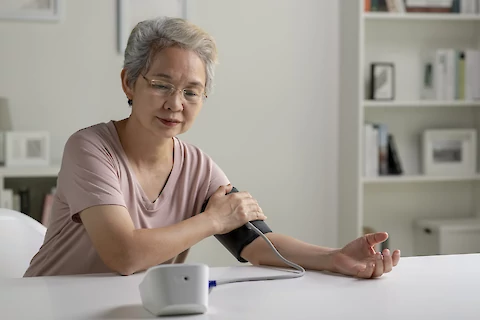
Monitoring blood pressure at home is essential to maintaining good health, especially as you age. High blood pressure can lead to a multitude of health complications if not properly managed. But how can seniors, particularly those receiving in-home care, effectively manage and monitor their blood pressure?
Blood Pressure: A Quick Primer
Understanding blood pressure is the first step in effectively managing it. Simply put, blood pressure is the force exerted by your blood against your artery walls every time your heart pumps. It is measured in millimeters of mercury (mmHg) and presented as two numbers. The top number represents the systolic pressure, the pressure when your heart beats, and the bottom number represents the diastolic pressure when your heart is resting. A reading below 120/80 mmHg is generally considered normal.
Why Regular Blood Pressure Checks Matter
Regular blood pressure checks are vital, especially for seniors. Blood pressure can vary throughout the day and can be affected by various factors such as stress, diet, and medication. Prolonged high blood pressure, also known as hypertension, can lead to severe health conditions like heart disease, stroke, and kidney disease. Routine checks provide valuable information on managing these risks and can even provide early warning signs of impending health issues.
Best Practices for Accurate Blood Pressure Readings
A home blood pressure monitor is a great tool to have on hand for accurate readings. It can give you peace of mind and help you keep things under control.
- Sit comfortably at a table or desk with your arm resting at heart level.
- Wrap the cuff around your upper arm and ensure it fits correctly - it shouldn't be too tight or loose.
- Before taking the reading, rest for at least 5 minutes.
- Smoking, drinking caffeinated beverages, or exercising should be avoided for at least 30 minutes before the measurement.
- Consistency is also crucial; aim to take your reading simultaneously each day and use the same arm for each reading.
When to Reach Out to Healthcare Providers
While monitoring blood pressure at home is an excellent way to keep track of your cardiovascular fitness, it doesn't replace regular check-ups with your healthcare provider. If multiple readings indicate high blood pressure (typically a reading of 130/80 mmHg or above), it's time to consult your healthcare provider. Immediate medical attention is necessary if you experience symptoms like severe headaches, chest pain, or shortness of breath. Regularly share your readings with your healthcare provider to ensure that any potential health issues are promptly addressed.
Senior Helpers St. Petersburg Can Help Seniors Monitor Their Blood Pressure
Monitoring blood pressure at home is crucial for senior health, and thanks to advances in home health technology, it's easier than ever before. If you're a senior living in St. Petersburg, Gulfport, South Pasadena, St. Pete Beach, or Treasure Island, don't hesitate to reach out to us at Senior Helpers St. Petersburg. We're here to assist you in maintaining your health and independence.